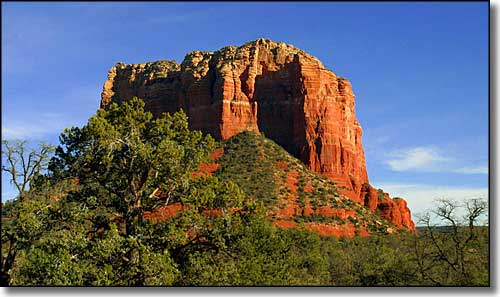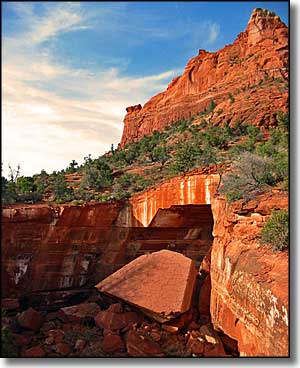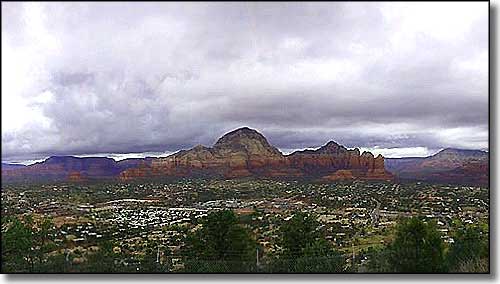
Sedona, Arizona

Courthouse Butte near Sedona

Sedona was named after Sedona Miller Schnebly (1877-1950), wife of Sedona's first postmaster. What makes the town notable is the vast array of red sandstone formations in the area. Those red formations are formed by the Schnebly Hill Formation, a thick layer of red to orange-colored sandstone that is only found around Sedona. A member of the Supai Group, the Schnebly Hill Formation was deposited during the Permian period.
Before the "Americans" first arrived, the area of Sedona was inhabited by the Yavapai-Apache Tribe of Native Americans. Fort Whipple was established near present-day Chino Valley in 1854 and Anglo settlers started to move in. Over time, friction with the Yavapai and other local tribes grew until the Yavapai-Apache and the other tribes were forcefully removed to the San Carlos Indian Reservation in 1876. About 1,500 tribal members were forced to march that 180 miles to the reservation in mid-winter. Hundreds of them died along the way. The survivors were interned for 24 years and were finally allowed to return to their ancestral homeland in the Verde Valley in 1900.
In 1879, the first Anglo settler arrived in Oak Creek Canyon and set up shop. In the beginning, the settlers were ranchers and farmers, and Oak Creek Canyon built up a reputation for excellent apples. By 1902 there were 66 people using the Sedona Post Office. Growth was slow because the 1955 phone book listed only 155 names. Parts of Sedona didn't even have electricity until the 1960's, about the same time tourism really started to take off in the area.
In the 1980's, Sedona's reputation among the retirement set started to take off and development really began. At this point, there are no large tracts of land left to be developed: the limit has already been reached. Population pressure in the area is such that in the Red Rocks District of Coconino National Forest (the area around Sedona and Oak Creek), if you want to park the car and go for a walk in the countryside, you need a $5/day permit. The city has grown to the point that it straddles the county line between Coconino and Yavapai Counties, but most of the city is in Coconino County.

Looking north across Sedona from Airport Mesa
Zip Codes: 86336, 86339, 86340, 86341, 86351
Latitude: 34.8599°N
Longitude: 111.7892°W
Incorporated: 1988
Elevation: 4,326'
Education:
High School or Higher: 90.9%
Bachelor's Degree or Higher: 39.2%
Graduate or Professional Degree: 16.6%
2011 Cost of Living Index for Sedona: 101.8
Estimated Median Household Income: $52,140
Estimated Median Home Value: $494,100
Median Resident Age: 50.5 Years
Major Industries:
Lodging & Food Services, Educational Services, Construction, Professional Services, Health Care, Real Estate Services, Arts & Entertainment, Retail Services, Finance & Insurance Services, Waste Management Services
Unemployed (March 2011): 8.5%
2010 Population Demographics
| Total Population | 10,031 |
| Males | 4,688 |
| Females | 5,343 |
| Population by Age | |
| Under 18 | 1,209 |
| 18 & over | 8,822 |
| 20-24 | 288 |
| 25-34 | 686 |
| 35-49 | 1,568 |
| 50-64 | 3,214 |
| 65 & over | 2,934 |
| Population by Ethnicity | |
| Hispanic or Latino | 1,438 |
| Non Hispanic or Latino | 8,593 |
| Population by Race | |
| White | 9,036 |
| African-American | 49 |
| Asian | 186 |
| Native American | 61 |
| Hawaiian or Pacific Islander | 14 |
| Other | 519 |
| Two or more | 166 |
